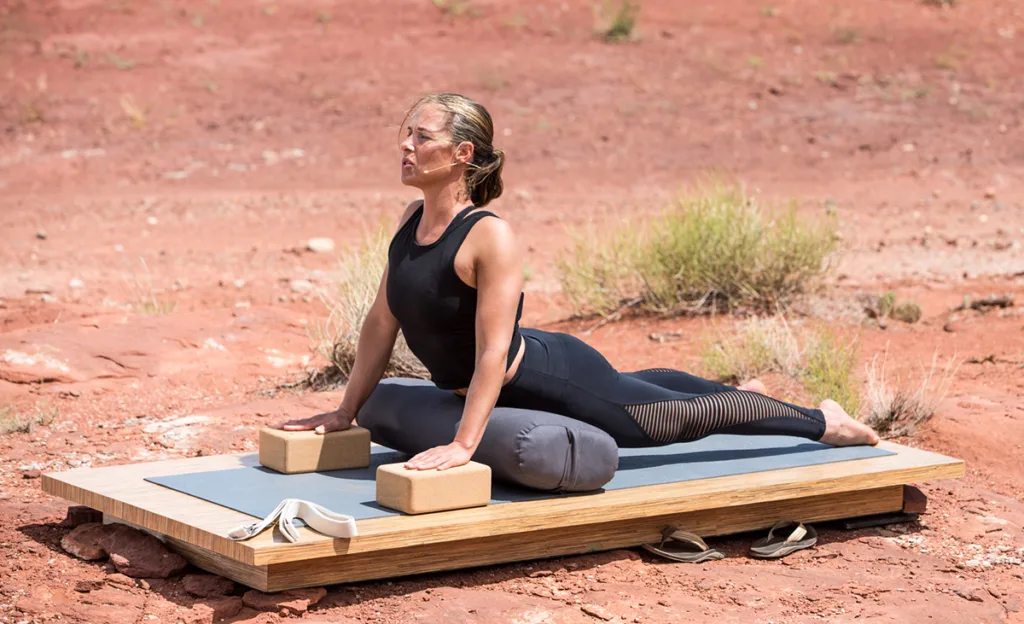
Upward-Facing Dog Pose (Urdhva Mukha Svanasana) is one of the key elements in Sun Salutations (Surya Namaskara). It’s often paired with its littermate Adho Mukha Svanasana (Downward-Facing Dog Pose), but it’s a worthy pose in its own right. Downward-Facing Dog Pose may be the better known of the two, but in this post we’ll let its less-famous sibling have its day.
Upward-Facing Dog Pose provides many benefits. Here are a few:
- Strengthens shoulders, arms, hands and wrists
- Counteracts the effects of too much sitting and bending forward
- Can relieve lower back pain
- Energizes the body and mind
Upward-Facing Dog Pose is named for a loyal dog that appears in the Mahabarata. If you’d like to know about the story behind the pose, check out Zo Newell’s article in Yoga International.
Challenges and Solutions for Practicing Upward-Facing Dog Pose
Urdhva Mukha Svanasana is a challenging pose. It strengthens the shoulders, arms, hands and wrists because it challenges them. There’s a tendency to collapse into the shoulders, hands and wrists in the pose. In order to avoid relying too much on these structures, it’s important to engage the rest of the body in the pose as well. The whole body needs to contribute to the lift in the pose. A Standard Yoga Bolster plus a couple Yoga Blocks can be extremely helpful in shifting the work in the pose to the lower body. This relieves pressure on your hands and wrists. I’ll explain how to use these props in the instructions below.
The other physical challenge in Upward-Facing Dog Pose is the tendency to stress the low back. If you practice the pose with your head thrown back so that you’re looking at the sky, you are probably creating extra stress on your back. Keeping your head in a neutral position in this pose helps to support your low back. This is due to the positioning of a small bone in the top of the throat, the hyoid bone. Here’s a post that explains how to use the hyoid bone to support the core in Chaturanga Dandasana (Four-Limbed Staff Pose). You can apply this information to any pose, but for the prone backbends, it’s especially helpful.
Contraindications for Practicing Upward-Facing Dog Pose
Before we dive into practicing the pose, I’d like to share some situations in which it might be best to avoid practicing Urdhva Mukha Svanasana:
- Injuries to your hands, wrists, shoulders or low back
- Second and third trimesters of pregnancy
- Recent abdominal surgery
- If you have a headache, skip practicing this pose.
How to Practice Urdhva Mukha Svanasana with a Yoga Bolster
- Gather your props: Yoga Mat, two Yoga Blocks, Standard Yoga Bolster.
- Place your bolster crosswise on your mat about ⅔ of the way toward the “head” end of your mat. Place your blocks, shoulders-width apart, in their lowest setting, directly in front of your bolster.
- Start in Downward-Facing Dog Pose with your hands on your blocks. You may notice that placing your hands on blocks shifts your weight back into your feet a bit more than usual.
- Shift your whole body forward and lower your hips onto your bolster. The hipbones should be resting on edge of the bolster.
- Engage your legs by isometrically lifting them up toward the ceiling. Press your feet down into the floor.
- Press down into your hands to lift the chest, keeping your elbows bent. Keep your head level, looking straight ahead.
- Take 5 to 10 deep breaths. Then shift back into Downward-Facing Dog Pose with your hands on your blocks.
- When you’re ready, release your knees down onto the floor and rest in Balasana (Child’s Pose). You can rest your forearms and forehead on your bolster for extra comfort.
